Attack on Titan, of course, is a massively successful — and popular — manga and anime series. This live-action entry is the Japanese film industry’s latest attempt to parlay manga and anime into cinema. Parlay? Sorry, plunder would be more fitting here.
The first live-action Attack on Titan film from director Shinji Higuchi is volume one in a two-part series, with the follow-up, the heavy-handedly titled Attack on Titan: End of the World, to open in September. Thank Kill Bill for kicking off the pay-to-finish-the-movie trend. This is no Kill Bill. Shinji Higuchi is no Quentin Tarantino.
Superficially, Attack on Titan sure seems like, you guessed it, Attack on Titan. It’s got the name and the logo. There’s a walled city. There are Titans. They eat people. There are characters with names you find in AoT, doing things you see in the manga or the anime, such as flinging about via Three Dimensional Manoeuvre Gear, slicing down those flesh-eating giants. It all looks like Attack on Titan, but it’s not.
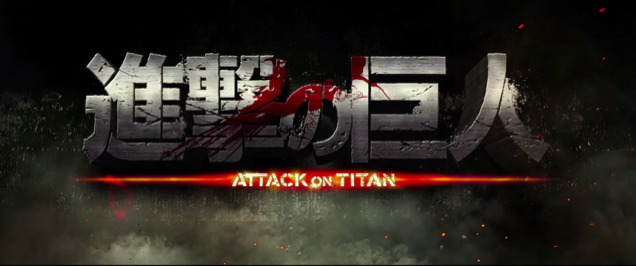
Picture: Toho
Walking out of my local IMAX theatre this weekend, my eldest son, a huge Attack on Titan fan, began railing against against all the changes the movie made to the manga. There are plenty. His chief grievances were what most Attack on Titan fans will probably have: That the movie’s changes don’t make Attack on Titan better, but worse. I agreed with him, adding grievances of my own: Forget this movie not working as an Attack on Titan adaptation, it doesn’t even work as a movie. Period.
We shouldn’t be too fussed with moviemakers changing the source material to make the film better. We should be when they make it worse.
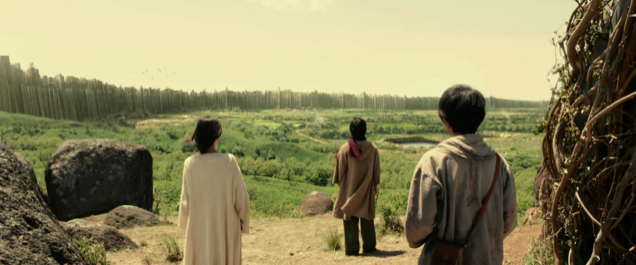
Picture: Toho
The picture opens with a series of exposition scenes that are so painfully melodramatic, badly acted, and wrought with corny dialogue, I spent the rest of the movie quietly wondering why I didn’t just get up and leave then. When these scenes don’t work and really begin to drag, some piano music or folksy violins are thrown in to emote feelings from actors that, simply put, look lost.

Picture: Toho
They weren’t the only ones. I felt lost, too. The best thing about the Attack on Titan manga and the anime is the vivid world. You get a strong sense of place. You do not get that in this film. Because you don’t have that, there’s no confidence in the filmmaker to take you somewhere else.
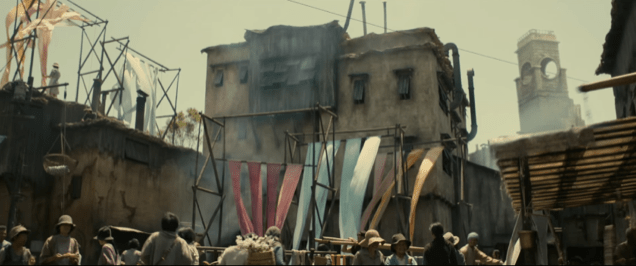
Picture: Toho
For all of the hullabaloo surrounding the decision to make the Attack on Titan characters Japanese instead of German or European, the movie might has well have been set in Germany. When the movie opens, we see a town that looks straight out of a JRPG, with medieval style European clothing as envisioned by Japanese people.
All of this is underscored by the music used in the film, with is either classical, choral, or, ungh, grating electric guitars and pulsating beats during the big battle scenes. I don’t recall seeing a film in recent memory with such discordant, feckless use of music. The score is so bad that it’s distracting. You know how the music in Battle Royale sets the mood? The music in Attack on Titan ruins it.
Then, later in the film, we end up in an area of destroyed Japanese block apartments. It’s clearly Hashima Island (aka “Gunkanjima” or “Battleship Island”). Everyone in Japan seeing the film will instantly know. The island recently became a World Heritage site, amid great controversy and great fanfare. This is one of the first industrialized places in Asia.
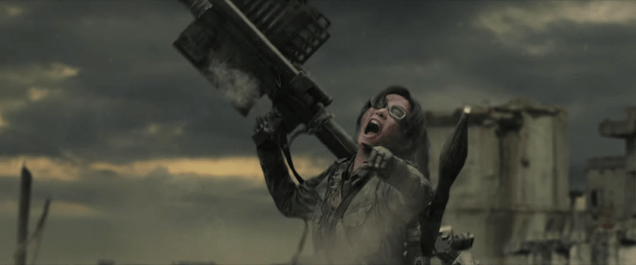
Picture: Toho
Yet, the movie isn’t interested in the island’s history (or even being daring enough to comment on said history), and doesn’t even really use its natural walled shape for any storytelling purposes, but rather, only cares about filming ruined Japanese apartments. In volume one, it seems cosmetic. For looks. That’s all.
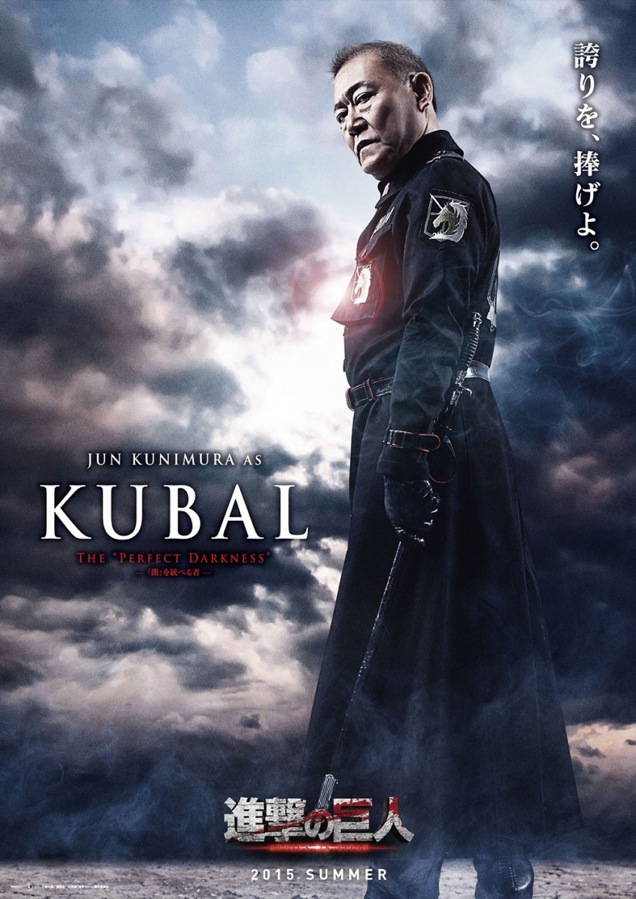
Picture: Toho
The changes are not only sometimes odd, but even tone deaf. Part of the controversy surrounding Battleship Island were allegations of forced labour. And yet, in the movie, the Military Police Brigade is decked out in S.S. Nazi-style black uniforms, complete with red armbands. The alteration is an obvious one, because the Military Police Brigade’s uniform look like this in the manga and anime.
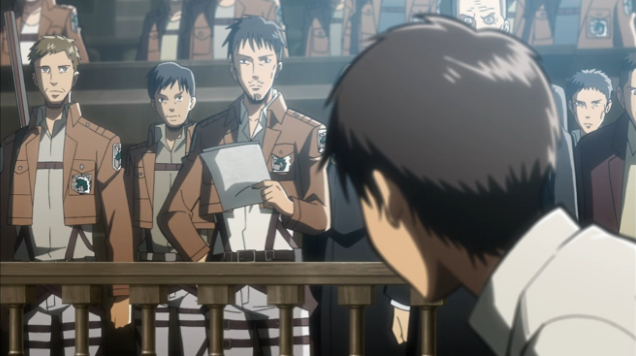
Picture: Attack on Titan Wikia
Is the assumption that the Military Police Brigade are as brutal as the S.S.? If so, we don’t see that in the first film, and the viewer will have to shell out another twenty bucks to find out in the second one. Or, is this another example of Japanese fetishization of German military uniforms? Or that, ungh, the original work’s German setting lends itself to this kind of iconography? This is precisely why this movie does not work as a standalone film. It sends mixed signals. The movie’s storytelling isn’t deft enough to handle such nuances — hell, it has enough problems dealing with attacking Titans in a compelling way.
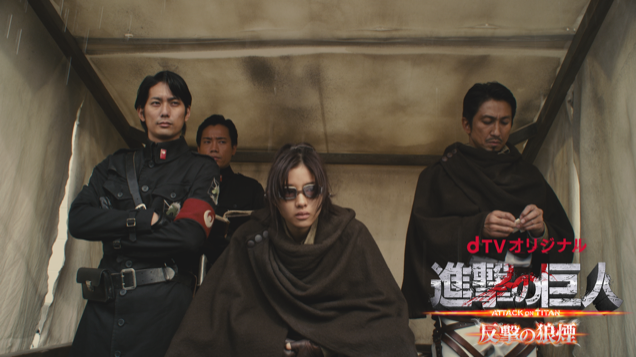
Picture: DMKT
The Military Police Brigade is corrupt in the manga, sure, but it’s not the effing S.S.
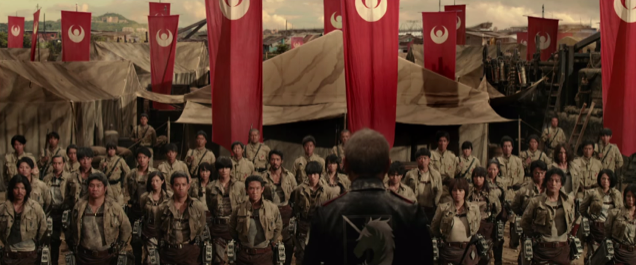
Picture: Toho
The red banners are also new, in case the red arm bands are not subtle enough.
Everything feels superficial. The title says Attack on Titan, and there are characters with names I’ve heard in Attack on Titan. But they’re not the same characters. Key moments are cast aside. Character motivations are either reworked, dissipated, or disregarded entirely. What makes these characters tick either isn’t shown or has been written out of the script entirely.
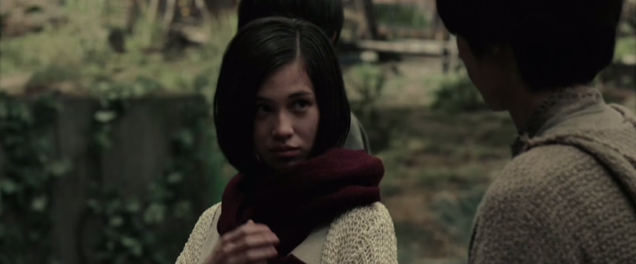
Picture: Toho
Take Mikasa, for example. In the manga, she is the last Asian person on Earth, something that probably hits home for Japanese readers. Here, in the movie, she’s just another Japanese character in a cast of Japanese characters. If that wasn’t enough (and apparently, it’s not!), the key scene with her and the scarf has been reworked to the point that it’s detrimental to the essence of her character. One of her most famous lines of dialogue in the manga is shortened in the movie, again, undermining her character.
One of the few ballsy things this movie did was ditching Levi, who is perhaps Attack on Titan’s most popular character. Whether or not this was a good idea is besides the point: The decision shows that the filmmakers were willing to take a risk. It was a dumb risk.
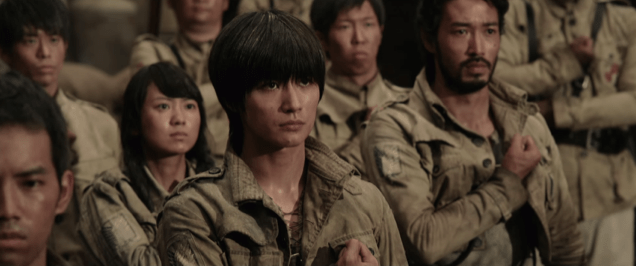
Picture: Toho
It’s only when the Titans show up that the movie becomes even mildly interesting. The CGI is, well, not great, but thankfully, the movie does have suit actors stumbling around. The film’s director, Shinji Higuchi, who made his name as one of Japan’s best special effects maestros, doing brilliant work on the fantastic 1990s Gamera movies, gleely films the Titans wreaking havoc. Some of the early sequences are filmed like horror movies with one terrific pay-off with a new Titan created for the film.
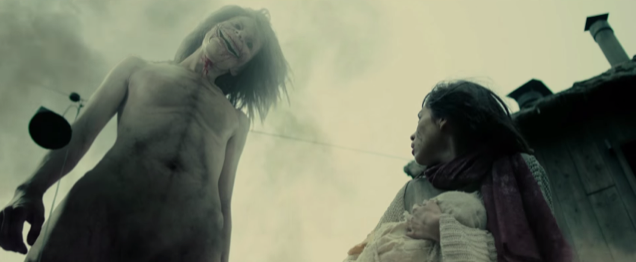
Picture: Toho
The live-action Attack on Titan movie is from Toho. You know, the studio that brought the world Godzilla. There are scenes at the end with actors in suits fighting in what looks like a miniature city. This is what Toho does best, and these scenes were far more thrilling than any of the movie’s lacklustre CG. Attack on Titan is, at its heart, a monster movie. This is what the whole film should have been: Actors in suits destroying little buildings. Not computer graphics.
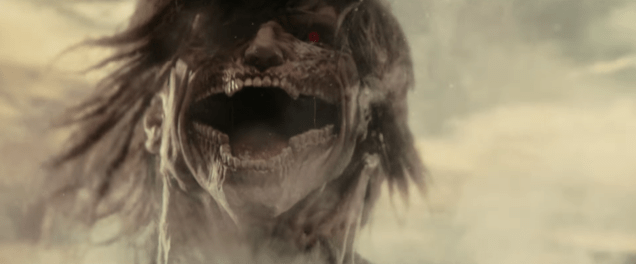
Picture: Toho
Shame, because in Attack on Titan, it seems like that’s the only thing Higuchi is interested in — filming actors in Titan suits. I know I was more interested in watching them. But there’s something wrong when the film’s best performances are the Titans’. Understandable, because the humans are either bickering, despicable, or worse, boring. If only the movie had more of an edge to it than its 12-and-up rating allows! The romance stuff falls flat and feels like it was shoehorned in to, probably in the eyes of a Japanese studio exec somewhere, make this more palatable as a date movie.
There’s a great Attack on Titan movie waiting to be made. This is not it. Let’s hope the sequel is.
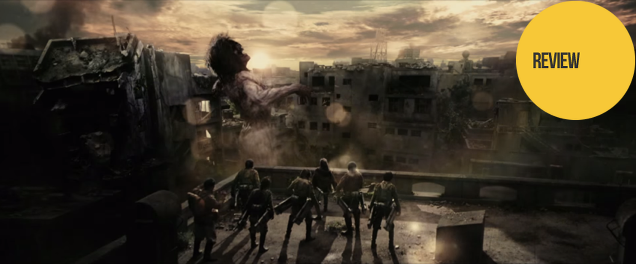
Comments
11 responses to “The Attack On Titan Movie: The Kotaku Review”
You’re telling me a cheap cash in on a popular (for some unknown reason) media comes off as cheap and almost nothing like the source material?
Must be a Thursday…
“exposition scenes that are so painfully melodramatic, badly acted, and wrought with corny dialogue”
Can I just say that this is my impression of the anime? I know that I might well get downvoted for saying this, but I wasn’t at all impressed by AoT after the first couple of episodes. Everything was just so melodramatic and poorly paced, and the dialogue was pretty overwrought and cliche. I’m sure the acting was as good as it could be, given the source material, but long, loud and emotional speeches lose their impact when you get one every episode or two and they happen more often than not in the middle of a desperate battle for survival.
Completely agree. I’ve watched both seasons. Too much exposition and working up to things that will happen and not enough of the things actually happening. Definitely too much melodramatic internal conflict in what’s-his-name’s head. We don’t need to hear word for word what he’s thinking; show us his internal struggles through his actions.
The second season hasn’t been released yet, no spoilers time traveller
both seasons? whats his name’s head? either you’re a troll or you’ve been watching a different anime buddy
I agree the first half of the season had way too many internal monologues…But give it a chance. The second half moves quickly and the payoff is worth it!
Nope, got almost to the end and then gave up. I just couldn’t enjoy it. Give me Fate/Zero or From The New World over AoT any day.
Exactly what I thought when watching (well, skipping through half of it) Attack on Titan. What’s with all the hype? It’s so damn slow and filled with whining kids. I don’t find the appeal to it, even after sitting through a few episodes without skipping. There are some good character development bits but I couldn’t care about them when I finished the season.
I enjoyed watching Magi: The Labyrinth of Magic more.
Sounds like Japanese movies suffer from the same problems Western ones do.
This movie is a stunning big-screen experience in classic giant monster cinema. Expertly made, terrifying. Just saw this at the Fantasia Festival in Montreal. The audience WENT WILD! Forget any other version of the story when you go to this, let the movie tell you what it wants to say, then sit back and just go with it.
If the details is stopping the enjoyment for you, so be it. But if anyone reading this liked the classic throwback element of Fury Road, watching the director of Gamera bring a seasoned hand to what he knows how to make best, a Gamera-like horror film, then run like crazy and see this one big.
It’s loud, beautiful, completely cheesy in all the right ways, ludicrous to be sure, and just great rock and roll circus cinema.
What the big screen does well, this film was made for.
I’m going again, before soaking myself in the experience of this madcap Japanese nightmare vision becomes only available on the tiny little electronic window in my living room.
See. It. Big.
TL:DR weeaboos will spend years whining about it, normal people will probably enjoy it.
I have to agree with this article, as an avid Attack on Titan fan I find it extremely disappointing the way the film makers have essentially created a new series and ignored the anime and manga series. What annoyed me the most, (and I haven’t even seen the film yet) is that mikassa is basically a nobody, in the anime series the last Asian on the planet, (and the reason she is saved as a child) because she is like everybody else wouldn’t she of been murdered even before attack on Titan? Furthering this (correct me if I’m wrong) she has no relevance in the series. Some other things, is that a RPG, why is this in japan not Germany, and is this in a different era or time or something.